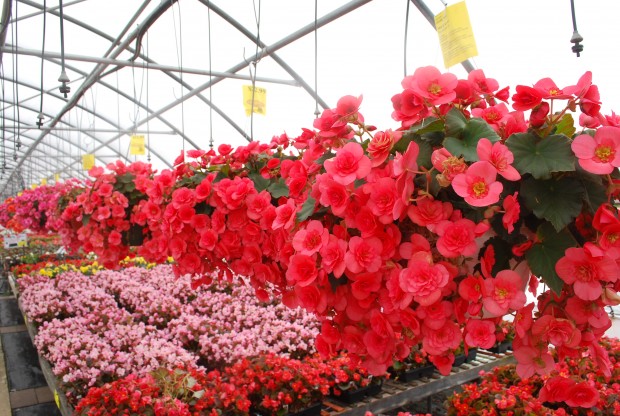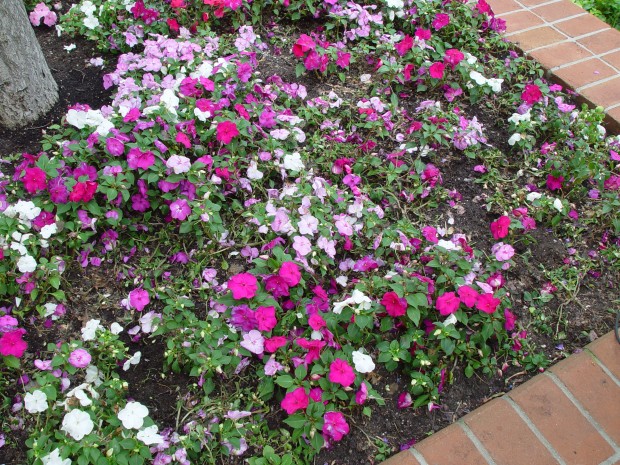 I have a big love for all of the annual plants that are available to augment my garden. Many of them come from tropical climates. One of the most popular annual plants of all time is impatiens walleriana. This plant grows readily in the heat, and covers itself with self cleaning flowers in a wide range of colors. Impatiens also tolerates a good bit of shade. They are happy in the sun, given sufficient water. They are the workhorse of annual shade bedding plants. That said, the impatiens are sick. A fungal disease that causes the plants to collapse in a rotten mess has infected our area. This picture, taken in 2009, at the one place I plant impatiens, tells the tale. I was so sure the client was over watering. I know now the plants were diseased. This devastating disease has affected impatiens plants all over the globe. There has been lots of discussion about planting impatiens this year in my area. I believe those major growers who are brave enough to suggest the disease is currently inherent in the seed. The upshot-should you find a nursery this season who still offers impatiens for sale, be advised that your purchase comes with an expiration date. Preventative applications of fungicide may stave off the disease, but once the disease is present, there is no cure. Any places planted with impatiens last year should not be replanted with them this year. No matter how much you love impatiens, the look of the plants in the picture above is not a good look.
I have a big love for all of the annual plants that are available to augment my garden. Many of them come from tropical climates. One of the most popular annual plants of all time is impatiens walleriana. This plant grows readily in the heat, and covers itself with self cleaning flowers in a wide range of colors. Impatiens also tolerates a good bit of shade. They are happy in the sun, given sufficient water. They are the workhorse of annual shade bedding plants. That said, the impatiens are sick. A fungal disease that causes the plants to collapse in a rotten mess has infected our area. This picture, taken in 2009, at the one place I plant impatiens, tells the tale. I was so sure the client was over watering. I know now the plants were diseased. This devastating disease has affected impatiens plants all over the globe. There has been lots of discussion about planting impatiens this year in my area. I believe those major growers who are brave enough to suggest the disease is currently inherent in the seed. The upshot-should you find a nursery this season who still offers impatiens for sale, be advised that your purchase comes with an expiration date. Preventative applications of fungicide may stave off the disease, but once the disease is present, there is no cure. Any places planted with impatiens last year should not be replanted with them this year. No matter how much you love impatiens, the look of the plants in the picture above is not a good look.
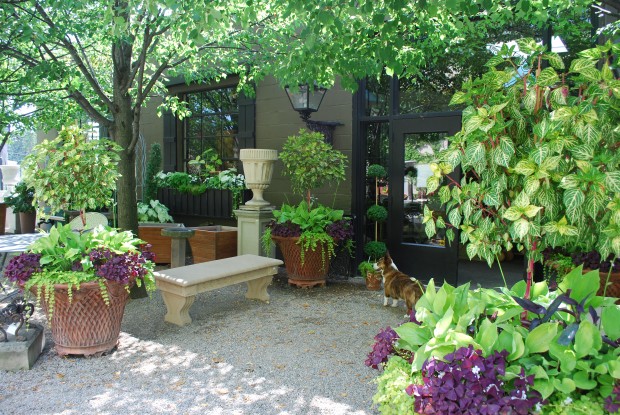 The list of annual and tropical plants that tolerate shady locations is considerable. The toughest part is getting past the fact that a favorite plant in a favorite color is not available. On the positive side, adverse conditions can produce some very interesting and creative results. Green shade plants such as the irisine standards pictures, hostas, creeping jenny are not prized for their flowers, but the leaves are strikingly colorful. The same goes for the oxalis and Moses in the cradle. The flowers are not so showy, but the leaf color is spectacular.
The list of annual and tropical plants that tolerate shady locations is considerable. The toughest part is getting past the fact that a favorite plant in a favorite color is not available. On the positive side, adverse conditions can produce some very interesting and creative results. Green shade plants such as the irisine standards pictures, hostas, creeping jenny are not prized for their flowers, but the leaves are strikingly colorful. The same goes for the oxalis and Moses in the cradle. The flowers are not so showy, but the leaf color is spectacular.
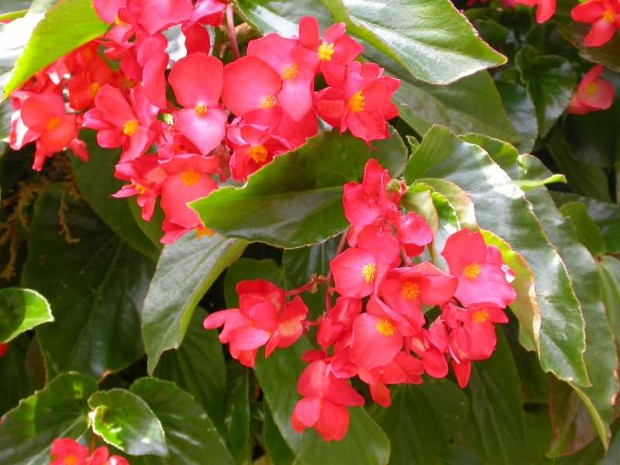 Dragon wing begonias are quite tolerant of shade, though the colors tend towards the yellow reds, coral and orange-not at all like the bluish pinks so common in impatiens. The appearance of the color of this plant has everything to do with the color of its companion plants. Yellow will make this flower appear more coral orange. A red violet companion makes this begonia appear more rose red.
Dragon wing begonias are quite tolerant of shade, though the colors tend towards the yellow reds, coral and orange-not at all like the bluish pinks so common in impatiens. The appearance of the color of this plant has everything to do with the color of its companion plants. Yellow will make this flower appear more coral orange. A red violet companion makes this begonia appear more rose red.
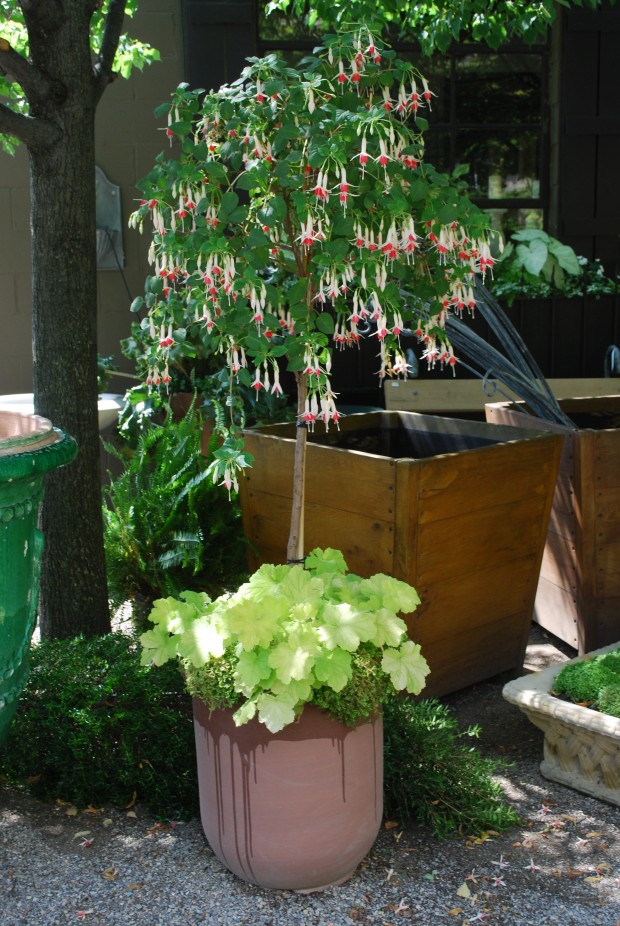 Fuchsia flowers may be small, but they have a very interesting shape, and come in a wide range of colors. A fuchsia on standard makes a great centerpiece in a container planted for shade. This fuchsia “Ballerina” will flower next to a north wall, all summer long.
Fuchsia flowers may be small, but they have a very interesting shape, and come in a wide range of colors. A fuchsia on standard makes a great centerpiece in a container planted for shade. This fuchsia “Ballerina” will flower next to a north wall, all summer long.
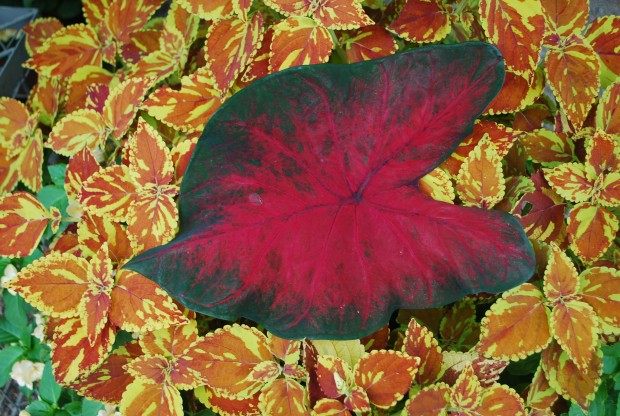 Few shade tolerant annuals can rival coleus and caladiums for dramatic color and form. For many years coleus did not interest me that much. The colors looked so muddy. New cultivars have very clear and vibrant colors. They old standard caladiums have a lot more company these days. The arrow and strap leaf caladiums have a saucy shape, and are visible from quite a distance. The new white cultivars are very bright in shady locations.
Few shade tolerant annuals can rival coleus and caladiums for dramatic color and form. For many years coleus did not interest me that much. The colors looked so muddy. New cultivars have very clear and vibrant colors. They old standard caladiums have a lot more company these days. The arrow and strap leaf caladiums have a saucy shape, and are visible from quite a distance. The new white cultivars are very bright in shady locations. 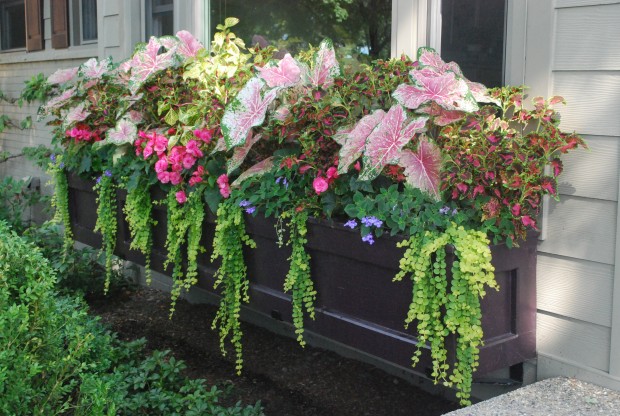 Variety is the spice of life, yes? In my opinion, the planting in this window box is much more visually interesting than a mass of impatiens. A good design assembles a collection of materials that look good together. Sometimes, the relationship between one element and another is vastly more interesting that the individual element alone. I do understand that there is a financial aspect to the impatiens debacle. An impatiens plant runs between .25 and .40 each. A single 4″ pot of coleus is 10 times that much. But many growers are offering coleus and seed New Guinea impatiens in flats. Some larger growing shade annuals can be found in 6 packs-18 plants to a flat. Other alternatives? Take the most ordinary white fibrous begonias in flats, and plant them in interesting shapes, swirls and stripes. Make the statement with a shape, rather than a specific variety. Impatiens has a tendency to get massive and shapeless by summer’s end. A planting of white or pick or red fibrous begonias can hold an intricate shape or pattern. A mix of three colors is more sparkly and interesting than one color. Those begonias can be punctuated with a 4″ pot of some other shade tolerant annual every so often. Another tip-fibrous begonias with dark leaves have a dour muddy look-stick with the green leaved varieties, unless you have a whole “other than green” foliage idea in mind.
Variety is the spice of life, yes? In my opinion, the planting in this window box is much more visually interesting than a mass of impatiens. A good design assembles a collection of materials that look good together. Sometimes, the relationship between one element and another is vastly more interesting that the individual element alone. I do understand that there is a financial aspect to the impatiens debacle. An impatiens plant runs between .25 and .40 each. A single 4″ pot of coleus is 10 times that much. But many growers are offering coleus and seed New Guinea impatiens in flats. Some larger growing shade annuals can be found in 6 packs-18 plants to a flat. Other alternatives? Take the most ordinary white fibrous begonias in flats, and plant them in interesting shapes, swirls and stripes. Make the statement with a shape, rather than a specific variety. Impatiens has a tendency to get massive and shapeless by summer’s end. A planting of white or pick or red fibrous begonias can hold an intricate shape or pattern. A mix of three colors is more sparkly and interesting than one color. Those begonias can be punctuated with a 4″ pot of some other shade tolerant annual every so often. Another tip-fibrous begonias with dark leaves have a dour muddy look-stick with the green leaved varieties, unless you have a whole “other than green” foliage idea in mind. 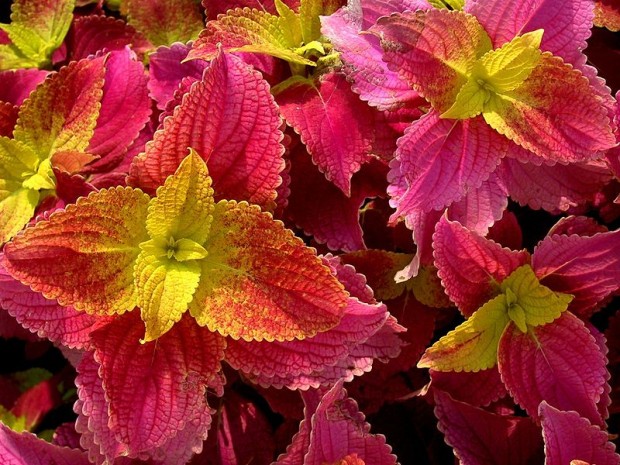 But the best of this bad situation is a chance to become acquainted with plants you may have passed by before. There are some very beautiful plants out there, looking for a home for the summer.
But the best of this bad situation is a chance to become acquainted with plants you may have passed by before. There are some very beautiful plants out there, looking for a home for the summer.
 coleus and solenia orange begonias
coleus and solenia orange begonias
 This container does have a dash of color courtesy of a blob of lipstick impatiens. But that impatiens is by no means the star of this show.
This container does have a dash of color courtesy of a blob of lipstick impatiens. But that impatiens is by no means the star of this show.
